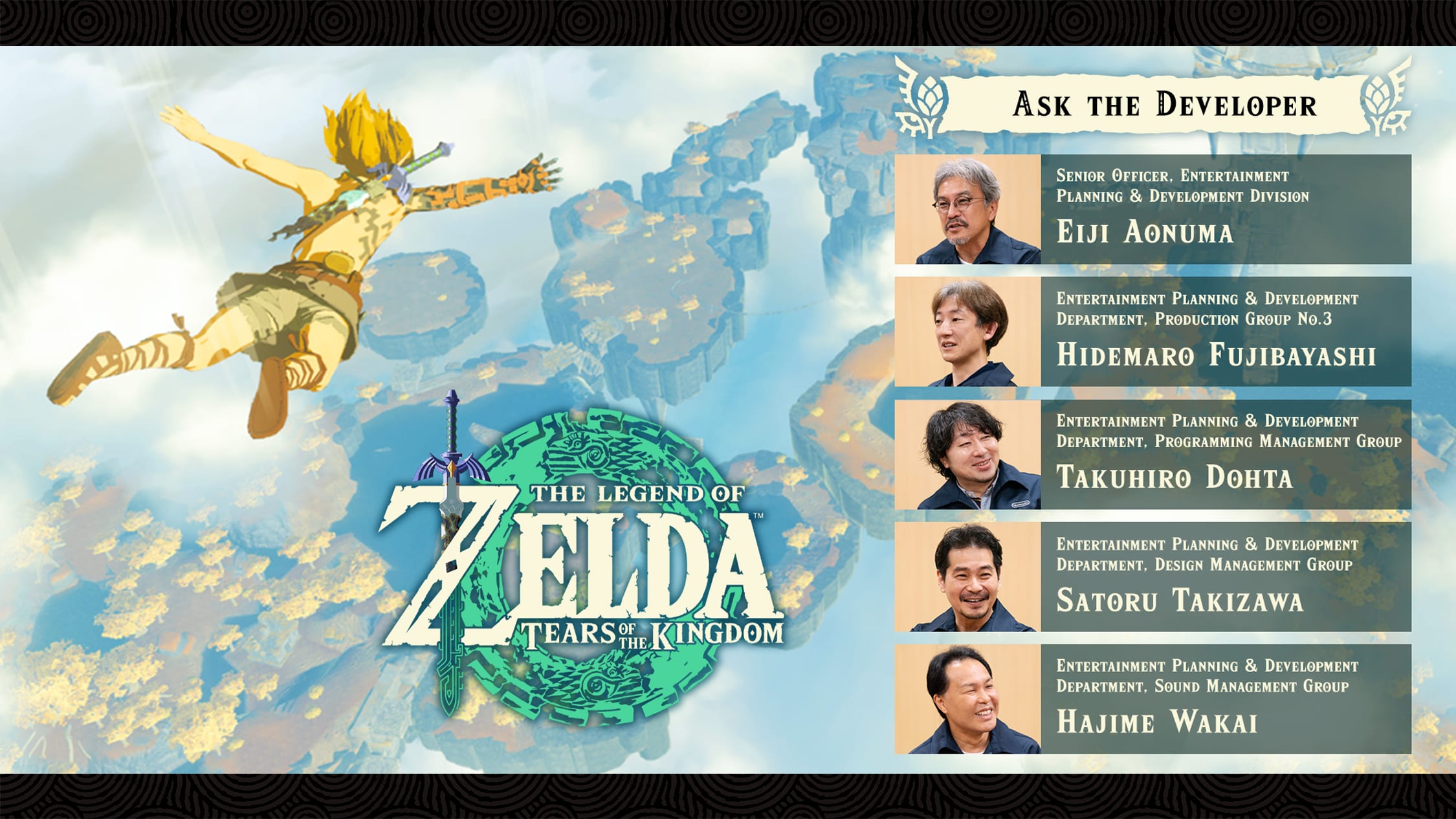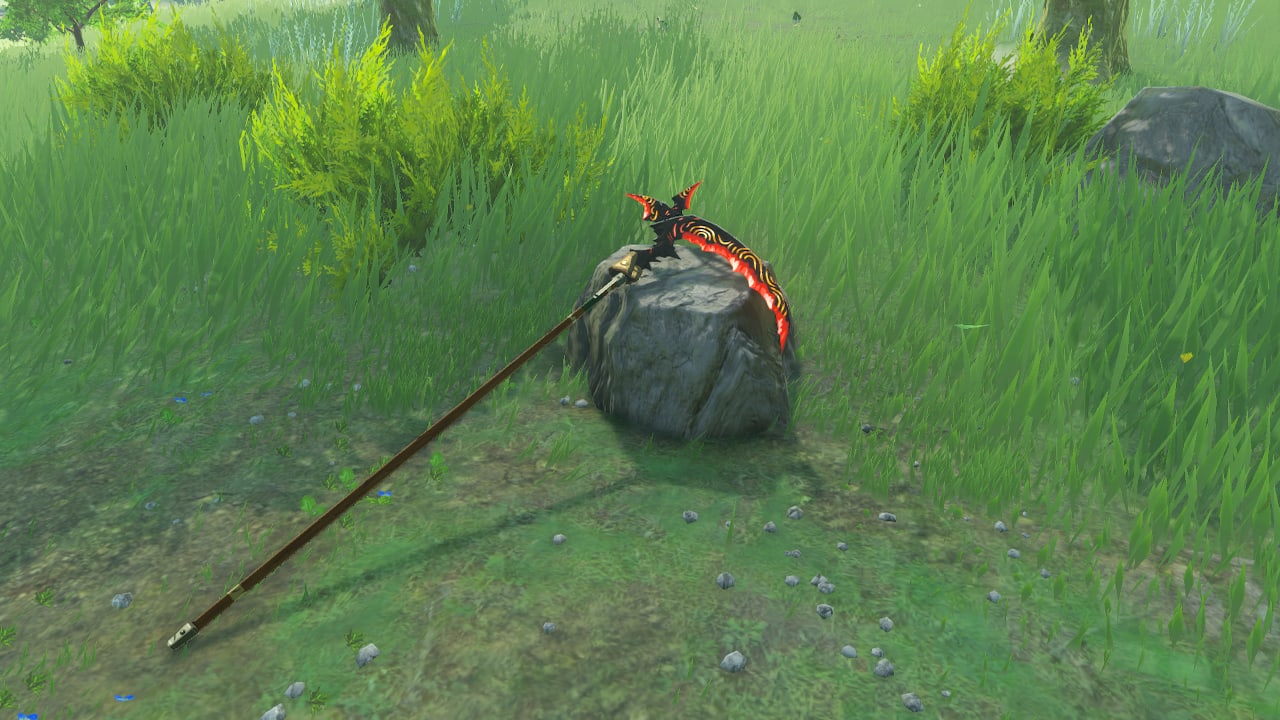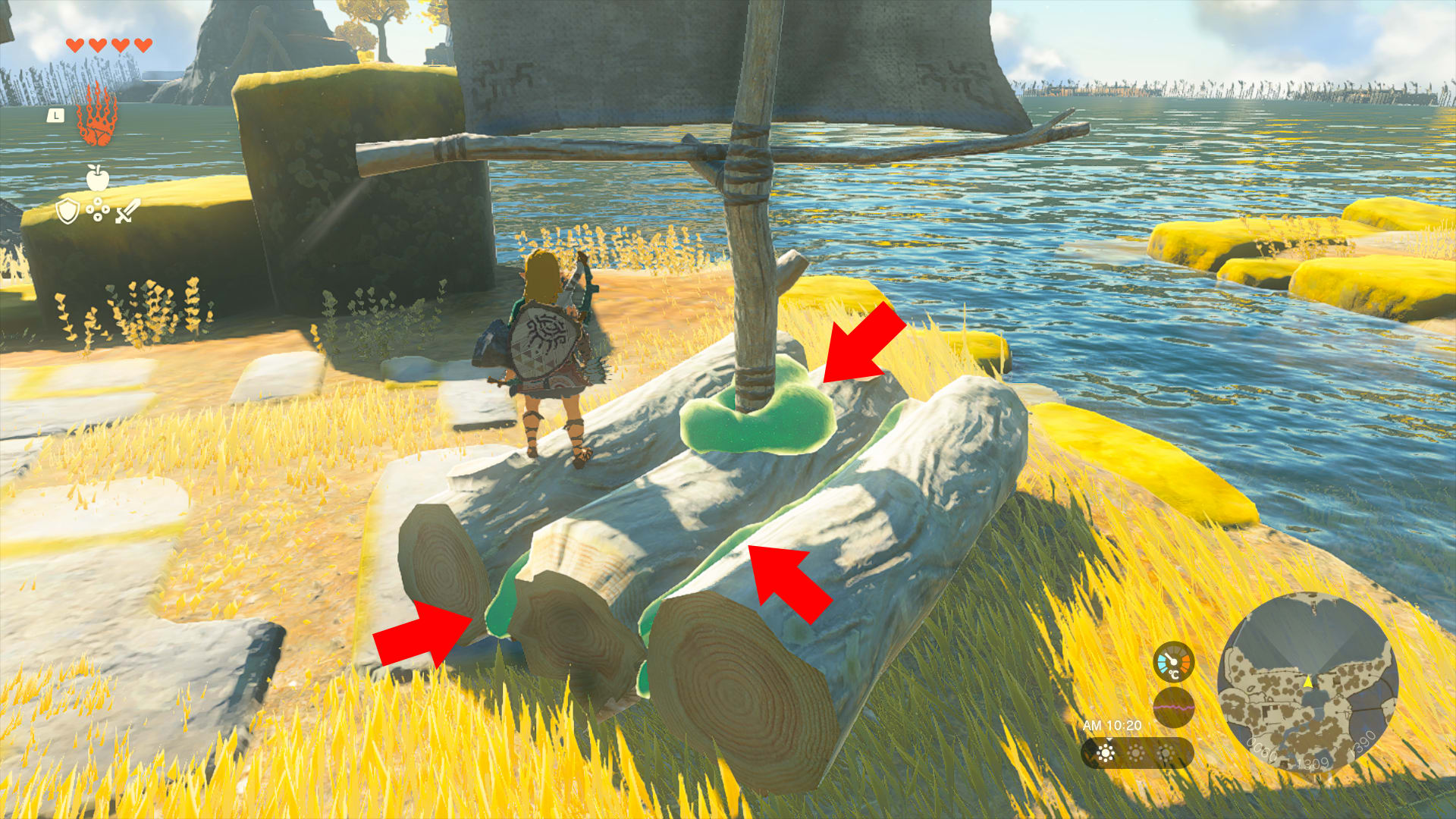
Ask the Developer Vol. 9, The Legend of Zelda: Tears of the Kingdom—Part 4
This article has been translated from the original Japanese content.
The images shown in this interview were created during development.
Check out the rest of the interview:
Part 4: What makes the game “The Legend of Zelda-like”
I know that "breaking the conventions of The Legend of Zelda™" was the theme behind the previous title. However, it seems that "breaking the conventions of sequels" was the concept for this title because it's filled with many new elements despite being a sequel.
Dohta: Yes, that's right. As we were having this discussion, I was thinking that if we had created the game from scratch in a completely different world, we might have ended up with something with a similar gameplay feel to the last one, just with a different map.
Fujibayashi: I think he has a point. We often say that we should “create games through multiplication. ”For example, we believe that taking the main character's ability and multiplying it with a world that has a lot to offer will result in a different experience for every player, every time. For the sequel, as we wanted to keep offering a different experience every time, without changing the world that has a lot to offer, it was only natural for us to change the main character's ability and create something new. That's why we completely redesigned Link's abilities.
Link's abilities shown in Aonuma-san's recent gameplay video were completely new and different from those of the last game. But when you say they have been completely redesigned, do you mean all his abilities are different?
Aonuma: Yes, they are all new. You'd be wrong if you thought the abilities were the same as before. (Laughs) In particular, one of the things that sets this title apart, the fun of attaching objects to each other, was something that Fujibayashi-san brought up in the early stages of development, saying, “This is the gameplay I want to implement in the sequel!”
Fujibayashi: Back then, I tried creating vehicles using only the mechanisms and parts available in the previous game and presented them.
For instance, I used spinning cog wheels as tires and attached four of them to a board to create a car. I also made a paddle steamer by attaching boards to those self-rotating cog wheels. By assembling stone slabs into a gun barrel and using a Remote Bomb, I also created a cannon that shoots Ancient Spheres. I attached it to a car to create a tank. (Laughs) By showing these ideas, I proposed that if Link had the ability to attach things together, we could create this new kind of gameplay using materials we already had available. This was how we came up with the idea of creating vehicles with the Ultrahand ability in this title.
I see, so the idea of attaching objects together to create something was present from the early stages of development. Watching Aonuma-san's gameplay video, it was intuitive and easy to understand what you can do by attaching things.
Dohta: The object-to-object combinations are something our designers and programmers put a lot of effort into adjusting because of the sheer number of variations. I want players to experiment with lots of combinations and find their favorite.
Takizawa: Not only can you attach objects with the Ultrahand ability, but you can also build weapons with the Fuse ability, so the variety of combinations is truly massive. Our staff worked hard to make special adjustments to each item to ensure players wouldn't be disappointed and think, “This isn't what I expected...” Thanks to their efforts, we developed lots of attractive weapons that could be created with the Fuse ability. You can create a spear that looks like the Grim Reaper's scythe, for example.

Aonuma: But you see what looks like glue bulging out in between the attached objects, right? At first, I was shocked and thought, “What?! Are we really going with this?” (Laughs)

Takizawa: Did I just get called out...?! (Laughs) But I’m pretty sure that was the most obvious way to express whether the objects are attached or not. I'm quite confident of that. (Laughs)
Wakai: That expression of glue-like substances was also perfect from a sound design perspective because it was easy to translate into sound in real life. So for that, I'm very thankful. Rather than unrealistic, abstract sounds, “unrefined sounds” that give players a more realistic sense of texture and accomplishment often feel right for Legend of Zelda games. As this game involves repeatedly attaching and detaching objects, we needed to develop a sound effect that informs players that an object is now ready to be attached. So regardless of what objects you're sticking together, you'll always hear the same “attaching sound.” Since it's a sound that you will hear over and over again, we thought the key was to create something that would give players a feeling of accomplishment so that they could genuinely enjoy the process.

Fujibayashi: Once we decided on the look and added sound effects, I felt a sense of achievement the moment the objects were attached, and it was very satisfying.
Aonuma: Yeah, whatever you make, you end up feeling good about it.
Dohta: We originally wanted to implement this gameplay so people could enjoy simply attaching things rather than building something substantial. It's like, “I attached tires to a log, and it moved forward! I know it looks a bit lame, but that's fine!” – that kind of feeling. In that sense, I think the glue symbolizes the fun of sticking things together. Even if you randomly stick things together, you'll still end up with something with a nice handmade feel. (Laughs)
Aonuma: Yes, so don't worry if you're not good at making things. If you attach two long things together, you can create something even longer. It's as simple as that. Though it may look odd, that makes total sense, because they're stuck together with glue. (Laughs) I think this is very Legend of Zelda-like, and I'm liking it.
Takizawa: But Aonuma-san, you were making a solid raft in that gameplay video, shaping it stylishly. (Laughs) You'll pass through that place early in the game, but you don't need to make such a solid raft to cross. If you want, you can cross without building a raft.
Aonuma: I know, but the purpose of that video was to show what's special about the game. I wanted to give players a clear example. (Laughs) I mean, who wouldn't want to cross a river on a self-made raft?!
Everyone: (Laughs)
Takizawa: Indeed, watching the development staff doing test plays, some people created very elaborate inventions, while others focused on efficiency and only used the bare necessities. It's interesting how a person's playstyle can say a lot about their personality.
Aonuma: I feel that designers, in particular, tend to create intricate inventions.
Dohta: By placing the "attaching" feature at the center of the gameplay, I think we have created a mechanism that meets the needs of both those who want to create something elaborate and those who only want to do the bare minimum needed in order to progress.
Fujibayashi: We were very conscious of finding the right balance.
It's nice that players can enjoy creating something elaborate, while those who just want to keep moving forward in the game don't have to think too hard, so people can enjoy the game in their own way.
Dohta: In terms of features, one of the things we ended up not including in the last game was “magic.” Previously, we had a Stamina Wheel for physical actions, but there was nothing equivalent to a “magic gauge.” This time, however, we wanted to incorporate that feature, so we added another unique ability: the magical Zonai Devices. As you can see in Aonuma-san’s gameplay demonstration video, you can generate wind or move objects with a Zonai Device. Using this power, for example, you can even create something absurd, such as an “omni-directional flamethrower.” There are many moments where you can cheat in a good way.
Aonuma: Well, you say magic gauge – its visual is actually a battery. (Laughs)

Everyone: (Laughs)
Takizawa: The initial concept of this game was to use the "supernatural power" of an unknown civilization, as opposed to the Sheikah civilization's “super ancient technology” in the previous game, so we decided to create lots of handy items with magical properties. However, even if we describe these items as “supernatural,” players won't use them unless they know what they are. So, this thing we were calling “magic” ultimately became...ahem, an electric fan.

Everyone: (Laughs)
Takizawa: Since we felt it was important for our players to get what those items are at a glance, our designers ended up creating various home appliances. (Laughs) Coming up with ways to present them as something supernatural in the world of The Legend of Zelda: Breath of the Wild was quite a challenge. It was a great opportunity for us designers to put our skills to the test. (Laughs)
Aonuma: If players are shown something they've never seen in real life, they'll have no idea how to use it. But if it looks similar to an everyday item, they'll understand how it should be used intuitively. Having these items in the world of this Legend of Zelda game where magic exists surprisingly worked.
I see how the fun of sticking things together and magic have both been expressed in a slightly comical manner, typical of the Legend of Zelda series, so that players understand how they work intuitively.
